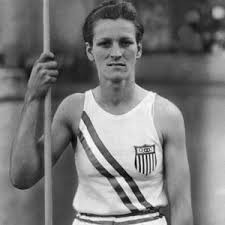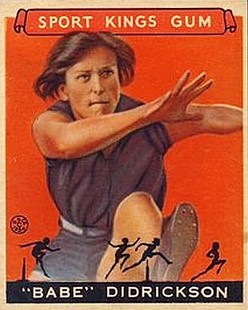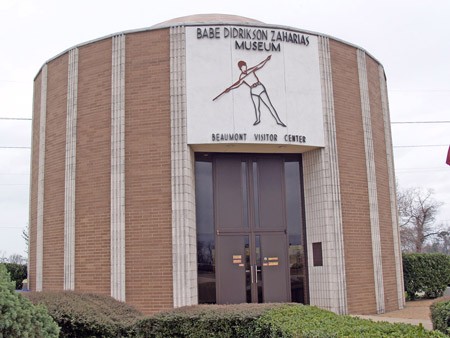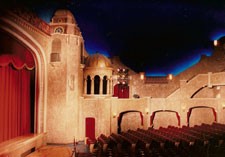Babe Didrikson Zaharias Museum and Visitor Center
Introduction
Text-to-speech Audio
Images
Babe Didrikson at the 1932 Olympics in Los Angeles

One of many Didrikson advertisements

The museum also serves as a welcome center, with staff who can help visitors discover other historic sites and places worth visiting through the city.

The interior of the museum includes exhibits, portraits, and artifacts related to the career and life of the era's most famous female athlete.

Backstory and Context
Text-to-speech Audio
Mildred Ella Didrikson was born in Port Arthur, Texas on June 26, 1911. Her mother, Hannah, and her father, Ole, were immigrants from Norway. She moved with her family from Port Arthur to Beaufort at the age of four. There is a rumor that she acquired the nickname “Babe” (after major league baseball player, Babe Ruth) after hitting five home runs in a childhood baseball game, but the reality was that her mother had called her “Bebe” (Norwegian for Babe) since she was a toddler.1
Mildred was the sixth of seven children and times were often difficult for the Didrikson family. Mildred worked at many part-time jobs, including sewing gunny sacks at a penny a sack. She was an excellent seamstress and made many of the clothes that she and her siblings wore. She won a sewing competition at the South Dallas State Fair in Beaumont in 1931. She attended school at Beaumont High School, but was never a successful student. She eventually dropped out with her parents’ permission and moved to Dallas to play basketball. It was here that her athletic career began to soar.
After a short but successful career in basketball, Babe turned her attention to track and field. Babe had read about the 1928 Olympics in her dad’s newspapers and decided that she wanted to be an Olympic athlete and began training with her sister, running through their neighborhood and jumping hedges as they went along.3 During the Olympic trials she qualified for five events, but women were only allowed to participate in three. At the 1932 Olympics in Los Angeles, she won two gold medals and one silver medal at the age of twenty-one. She received a gold medal for the javelin throw, a gold medal for the 80-meter hurdles, and a silver medal in the high jump.4
Didrikson is probably best known for her achievements in golf. She won 82 tournaments over her golfing career. She took up golf in 1933 and was considered a professional shortly after because she gave advertising endorsements. At the 1938 Los Angeles Open, Babe met her future husband, George Zaharias, a wrestler and part-time actor from Colorado. After a short courtship, they married in December of that same year. Four months after they married, George whisked her away on a vacation to Australia, but typical of their status as a power couple, he lined up an exhibition for her to play while there, and Babe’s sparkling personality had now become an international affair.5
In 1943, Babe was awarded amateur status as a golfer which enabled her to play in a wider array of tournaments. Between 1943 and 1947 she won 17 tournaments in row. In the 1940s women’s professional involvement in golf was limited. Her husband suggested that they create a women’s professional tournament circuit. George worked to find financial backers while Babe worked with fellow female golfer Patty Berg to co-found the Ladies Professional Golf Association (LPGA) in 1949. Berg was President of the LPGA the first year, and then Babe held the position for the rest of her life.6
In 1953 Babe was diagnosed with colon cancer and underwent a colostomy. She returned to the tournament circuit three months after the surgery. This was important to prove to spectators and to herself that she still had what it took to play professional golf. She won a few tournaments here and there, but never again played to the caliber for which she had been previously known. After battling her disease for over three years, Mildred Ella “Babe” Didrikson Zaharias passed away on September 27, 1956 in Galveston, Texas.7
She was voted the World’s Greatest Woman Athlete of the first half of the 20th century by the Associated Press, and was the only athlete to be named Woman of the Year by the Associated Press six times (1931, 1945, 1946, 1947, 1950, and 1954). She was named the Sports Illustrated “Female Athlete of the 20th Century—Individual Sports” and was named the 10th Greatest North American Athlete of the 20th Century by ESPN.8Sources
2. Van Atta Jr., Don. Wonder Girl: The Magnificent Sporting Life of Babe Didrikson Zaharias. Boston, Massachusetts. Little Brown and Company, 2011.
3. Freedman, Russell. Babe Didrikson Zaharias: The Making of a Champion. New York, New York. Clarion Books, 1999.
4. Babe's Life. Babe Didrikson Zaharias: World's Greatest Female Athlete. Accessed November 30, 2016. http://www.babedidriksonzaharias.org/?page_id=74.
5. Mildred Ella "Babe" Didrikson Zaharias (1911-1956). National Women's History Museum. Accessed November 30, 2016. https://www.nwhm.org/education-resources/biography/biographies/mildred-ella-didrikson-zaharias/
6. Mildred Ella "Babe" Didrikson Zaharias (1911-1956). National Women's History Museum. Accessed November 30, 2016. https://www.nwhm.org/education-resources/biography/biographies/mildred-ella-didrikson-zaharias/
7. Babe's Life. Babe Didrikson Zaharias: World's Greatest Female Athlete. Accessed November 30, 2016. http://www.babedidriksonzaharias.org/?page_id=74.
8. Babe's Life. Babe Didrikson Zaharias: World's Greatest Female Athlete. Accessed November 30, 2016. http://www.babedidriksonzaharias.org/?page_id=74.
